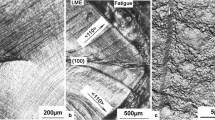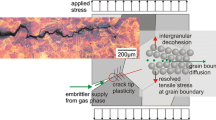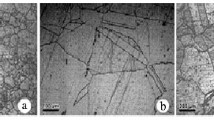Abstract
Cyclic crack propagation rates for a 65 pct nickel-33 pct copper alloy in low pressure, 0.013 MPa (100 torr), environments of hydrogen, oxygen, and nitrogen gas were compared to a reference crack propagation rate in a 1.3µPa vacuum. Crack propagation rates were determined over a range of temperatures for vacuum and hydrogen gas at a constant cyclic stress intensity. Crack propagation in the gaseous environment results in an increased crack propagation rate compared to growth rates in vacuum and a unique fracture mor-phology for each environment. Parallel investigations using transmission electron microscopy showed a unique dislocation structure adjacent to the fracture surface corre-sponding to each fracture morphology and environment. Fracture modes were transgran-ular in vacuum and nitrogen gas, transgranular with crystallographically-oriented features in oxygen gas, and intergranular over a range of temperature in hydrogen. A mechanism is suggested to explain gaseous environmental effects based on dislocation-gas atom inter-action.
Similar content being viewed by others
References
R. J. Walter and W. T. Chandler: Rockwell International, Rocketdyne, Canoga Park, California, Report R-7780-1.
D. P. Williams and H. G. Nelson:Met. Trans., 1970, vol. 1, p. 63.
H. G. Nelson, D. P. Williams, and A. S. Tetelman:Met. Trans., 1971, vol. 2, p. 953.
H. L. Marcus and P. J. Stocker:An Ultrahigh Vacuum System for Deter- mining the Effects of Gaseous Environments on Fatigue and Fracture Proper-ties of Metals, AGARD Conference Proceedings No. 98, Specialists Meeting on Stress Corrosion Testing Methods, Brussels, Belgium, 1969, reference 16.
W. M. Robertson: Science Center, Rockwell International, unpublished re- search.
S. Mostovoy, R. P. Crosley, and E. J. Ripling:J. Mater., 1967, vol. 2, p. 66.
H. L. Marcus and G. S. Sih:Eng. Fract. Mech., 1971, vol. 3, p. 453.
J. D. Frandsen, W. L. Morris, and H. L. Marcus: inHydrogen in Metals ASM p. 633, 1974.
R. P. Wei:Int. J. Fract. Mech., 1968, vol. 4, p. 149.
J. D. Frandsen, P. J. Stocker, and H. L. Marcus: Science Center, Rockwell International, Thousand Oaks, California, Report SCTR-72-17.
M. R. Staker and D. L. Holt:Acta Met., 1972, vol. 20, p. 569.
G.G. Hancock and H.H. Johnson:Trans. TMS-A1ME, 1966, vol. 236, p.513.
W. Hofmann and W. Rauls:Weld. Res. Suppi, 1965, vol. 44, p. 225S.
W. A. Spitzig, P. M. Talda, and R. P. Wei:Eng. Fract. Mech., 1968, vol. 1, p. 155.
L. H. Germer and A. U. MacRae:J. Chem. Phys., 1962, vol. 37, p. 1382.
L. H. Germer and A. U. MacRae:J Chem. Phys., 1962, vol. 36, p. 1555.
A. H. Purcell and J. Weertman:Met. Trans., 1973, vol. 4, p. 349.
F. E. Fujit: inFracture of Solids, D. C. Drucker and J. J. Gilman, eds., Interscience Publishers, p. 657, New York, 1963.
A. H. Cottrell and M. A. Jaswon:Proc. Roy. Soc, 1949, vol. A199, p. 104.
F. R. N. Nabarro:Theory of Crystal Dislocations, pp. 461-62, Oxford, London, 1967.
B. A. Wilcox and G. C. Smith: Acta Met., 1964, vol. 12 p. 371.
J. S. Blakemore:Met. Trans., 1970, vol. 1, p. 145.
A. H. Windle and G. C. Smith:Met. Sci. J., 1970, vol. 4, p. 136.
J. S. Blakemore:Met. Trans., 1970, vol. 1, p. 151.
A. H. Cottrell:Phil. Mag., 1953, vol. 44, p. 829.
T. Boniszewski and G. C. Smith:ActaMet., 1963, vol. 11, p. 165.
Anthony W. Thompson:Met. Trans., 1973, vol. 4, p. 2S19 ;Mater. Sci. Eng., 1974, vol. 14, p. 253.
R. Broudeur, J.-P. Fidelle, and H. Auchére: “Experiénce montrant le rôle des dislocations dans le transport de l'hydrogene,”L'Hydrogène Dans Les Metaux, Editions Science le Industrie, Paris, 1972.
M. R. Louthan, Jr., G. R. Caskey, Jr., J. A. Donovan, and D. E. Raul:J. Mater. Sci. Eng., 1972, vol. 10, p. 357.
A. H. Windle and G. C. Smith:M. Sci. J., 1968, vol. 2, p. 187.
M. L. Rudee and R. A. Huggins:Phys. Status. Solidi., 1964, vol. 4, p. K101.
A. S. Tetelman and A. J. McEvily, Jr.:Fracture of Structural Materials, pp. 267–71, John Wiley & Sons, New York, 1967.
Author information
Authors and Affiliations
Rights and permissions
About this article
Cite this article
Frandsen, J.D., Paton, N.E. & Marcus, H.L. The influence of gaseous environments on fatigue crack growth in a nickel-copper alloy. Metall Trans 5, 1655–1661 (1974). https://doi.org/10.1007/BF02646339
Received:
Published:
Issue Date:
DOI: https://doi.org/10.1007/BF02646339




